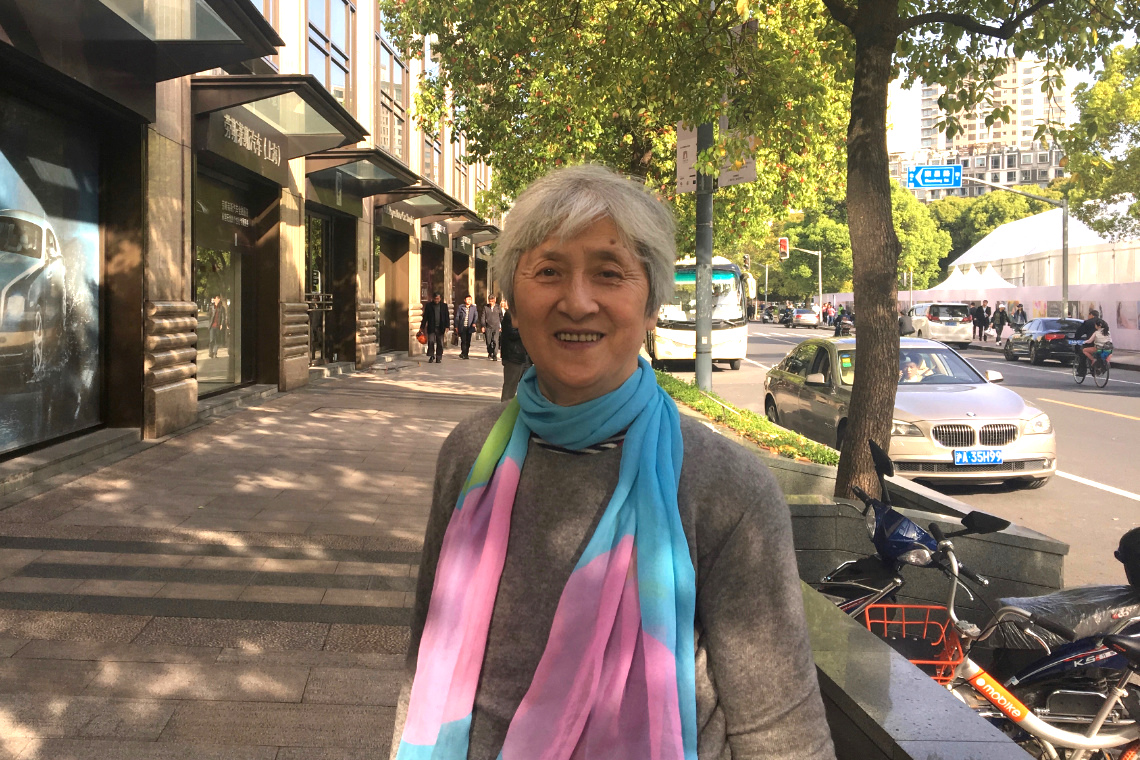‘Nobody talked about the disease’ — breast cancer in China
A look at how women in Shanghai — and all over China — are grappling with an increasingly common cancer.

SHANGHAI — When Xu Zhizhen 徐志珍 (pictured above) was diagnosed with breast cancer in 1985, she knew next to nothing about the disease. Only one other woman she knew had received the diagnosis — a colleague, younger than Xu, who had died before the age of 40.
“Nobody really talked about what caused her death, nobody talked about the disease,” says Xu. “I didn’t know how serious this was.”
A few months after a surgery successfully removed her tumor, Xu returned to work, taking on two different jobs. Her cancer returned two years later and, at age 42, she tried chemotherapy. “I was complaining about how I don’t feel well. My husband kept asking me, ‘Why do you feel this way?’” she says. “Back then, no one even understood what chemo was.” Unsure of the procedure, Xu decided to stop treatment. She turned instead to a mix of Chinese and Western medicines.
Things in China have changed drastically in the 30 years since Xu’s diagnosis. The country’s breast cancer incidence has risen twice as fast as in the rest of the world: Today, the disease is the most common cancer among Chinese women, as it accounted for roughly 12 percent (or 170,000) of the 1.4 million breast cancer cases diagnosed worldwide in 2008, and was diagnosed in the country approximately 278,800 times in 2013. Every year, the number and proportion increase, though exact data for more recent years is hard to pin down.
Dramatic increase in breast cancer rates
“The increase has been dramatic,” says Dr. Zheng Wei 郑苇, the principal investigator of the Shanghai Women’s Health Study, an ongoing, multi-decade health survey of 75,000 women in Shanghai. “In Shanghai, the incidence rate has about doubled compared with the rate 20 to 30 years ago.”
The sharp increase has triggered an urgency to develop prevention and treatment methods, but the response must contend with the complexities of China itself: The country’s vastness, a gaping divide between rural and urban healthcare, and a fluid population of 282 million migrant workers, about a third of whom are female, all complicate an already challenging situation.
But even as breast cancer rates among urban Chinese continue to increase at 2 to 3 percent per year, survival rates have also risen. Last month, the Shanghai Center for Disease Control announced that 9 in 10 women diagnosed and treated in the city have survived five years after diagnosis, a metric comparable with that for developed nations like the United States for stage II cancer. And while breast cancer is the most common cancer among women, it is only the fifth most deadly.
“About a decade ago, people would get so frightened when diagnosed with cancer, but now they’ve seen so much of it that it somehow became easier to accept,” says Hua Fangda 华方大, secretary of the Shanghai Cancer Rehabilitation Club 上海市癌症康复俱乐部, a support network with 16,000 members and 21 offices spread throughout the city. China’s rising breast cancer rate is reflected in the club’s membership: Nearly 4,500 breast cancer survivors represent the largest group in the club, which is over 70 percent women. Greater awareness and an expansion in the quality and variety of treatments available have all contributed to the public’s acceptance of the disease, Hua says.
Thirty years after beating the cancer, Xu, now 72, has stayed up to date on these latest breast cancer treatments, saying friends now call her a “half doctor.” But despite the technological advances she has seen, she says she still worries constantly about receiving the diagnosis again, something she’s seen other women go through. “I feel their pain, too,” she says of survivors with a repeat diagnosis. “I have no idea if [my cancer] would relapse or transfer or not. It is really hard to say.”


The effects of diet and pollution?
China’s burgeoning breast cancer incidence can be traced to a number of factors. Like other developing nations plagued with the same problem, one set of culprits can be found in an increasingly Westernized lifestyle — including diet, delayed childbirth, obesity, and alcohol use.
“Chinese women are adapting to a Western diet, which is fewer vegetables, lower fiber, and more animal foods,” says Dr. Zheng, who is also the director of the Epidemiology Center at Vanderbilt University. Zheng notes that while this Western diet is not definitively linked to breast cancer risk, strong evidence points to this association.
Women diagnosed with breast cancer often skew young, and rates are also significantly higher among Chinese urban women than among their counterparts living in rural areas. However, rates in rural areas are steadily on the rise as well. According to a recent report by researchers at China’s National Office for Cancer Prevention and Control, breast cancer in urban areas accounted for 19 percent of all new cancer cases in China, while rural diagnosis made up nearly 14 percent. Some researchers have even predicted that China will have more than 2.5 million breast cancer cases in 2021.
This is a typical trend in the developing world, explains Zheng. “[This] younger generation [was] exposed to the Western lifestyle at a younger age, so their lifetime risk is higher,” he says. “They bring the risk with them through their lives.” As this generation ages, its members will continue to pull up the peak age, or the age with the highest rate of incidence. Data is already showing this phenomenon.
The peak age is now between 50 and 55 years old. Roughly a third of Chinese women who are diagnosed with breast cancer are under 50. In China, breast cancer rates increase rapidly after age 30, whereas there is a similar rapid rate increase only after the age of 40. What this means is that the coming years will continue to see increases in breast cancer rates, and there will also be more older women who develop it.
Laura Sun 孙健 was shocked when she received her diagnosis at age 35. “I was scared, more than scared. I couldn’t accept it,” she says. “I heard that younger women could get this, but no one whom I knew.”
It wasn’t until Sun reached out to a local breast cancer support group in Shanghai, and met even younger women who were also facing the realities of the disease — endless testing, overnight stays at the hospital before chemotherapy appointments, loss of hair and appetite, an end to a normal lifestyle — that she began to accept her situation. More than that, she realized that she wasn’t alone.
Sun opted for chemotherapy and is now healthy. Today, a year and a half after receiving her final treatment, she says, “If I plan anything for my future, I put that in priority. What is good for me, and what is bad for cancer, that’s what I consider.” The risks and the concern, she explains, never go away.
It is important to note that individual cases such as Sun’s usually cannot be linked to a single or even specific set of causes, and that not all potential causes come from the West. Dr. Gu Yanfei 顾艳斐 of Beijing’s United Family New Hope Oncology Center says that China-specific factors like pollution and food safety are likely to contribute to climbing rates of breast cancer, though “the data will take time.” Research around the world has already suggested a link between breast cancer and pollution, from car emissions to industrial contaminants like polychlorinated biphenyls (PCBs), which China produces in steel and cement manufacture.
Traditional Chinese medicine
It’s common for breast cancer patients to seek both Eastern and Western procedures for treatment. China’s hospitals provide the global-standard treatments of radiation, chemotherapy, and drugs, selected from a tightly controlled list of approved imported and domestically developed medicines. Yet many cancer patients choose to supplement this course with herbal treatments prescribed by Chinese traditional medicine doctors. Chinese traditional medicine hospitals have also established designated departments to care for cancer patients, whose treatment is heavily subsidized by the government.
“Our main target is to treat postsurgery patients,” says Dr. Wu Liying 吴丽英, deputy director of the oncology department at Shuguang Hospital Affiliated to Shanghai University of Traditional Chinese Medicine. “Cancer surgery as well as chemo and radiation therapy have many side effects. There are not many effective Western treatments available for those side effects, and this is where Chinese traditional medicine comes in. This is our strength.”
The Chinese traditional medicine treatments are not typically aimed at curing cancer, but rather at reducing the side effects of therapy and focusing on the overall health of the healing body, says Wu. She noted that breast cancer patients make up a large proportion of their patients because there is an extended period of possible recurrence compared with other forms of cancer.
“Some patients keep coming back for several years because they fear the cancer returning,” she explains.
Government programs and screenings
As hospitals, both traditional and Western, are contending with the rising number of patients coming through their doors, more attention is being paid to combating breast cancer from the top down. In the past 10 years, the government has rolled out a large-scale “two-cancer” health program in rural China, screening for breast and cervical cancer. City governments have implemented their own initiatives, like Shanghai’s free screenings for certain retired or low-income women. The number of grants for breast cancer research from the National Science Foundation of China more than tripled from 87 in 2008 to 274 in 2013. Meanwhile, greater collection and use of data on Chinese women’s own physiology has enabled the country’s health services to tailor treatment and prevention options to local health circumstances, rather than copying Western models. For example, higher breast density in Chinese women means that ultrasound screenings can be more effective than mammograms.
The medical community has increasingly focused on prevention and early detection, launching large-scale screening drives on the ground and forming ties between local and urban hospitals to raise awareness in rural communities.
Dr. Gu of the United Family New Hope Oncology Center says that women with early-stage tumors have a much better chance of recovery if diagnosed early. “Because the knowledge is not so common, people have no common sense on this. Most people don’t have a regular physical checkup.”
Often this means that by the time most patients reach a hospital, they already have advanced or late-stage cancer. Gu considers it her and her colleagues’ responsibility to spread the word about screenings or how to conduct self-exams, whether it’s through WeChat or online video streaming. “Our aim is to find more early-stage cases,” she says.
Unfortunately, lack of awareness is not the only barrier for women to be proactive about breast health.

“Local hospitals are so busy that if you just want to do a screening, you will be in line for a very long time,” says Maggie Fu 傅博雪, director of programs at United Foundation for China’s Health (UFCH). Screenings, which typically refer to breast exams conducted by ultrasound, can require up to three appointments: the first for registration, a second for the exam itself, and a third to pick up results.
UFCH has launched a project that aims to deliver a solution: Wheels for Life, a roving van geared with medical equipment offering mobile checkups for children and adults who might otherwise have limited access to medical services, which also includes a state-of-the-art breast imaging technology, donated to the group by GE Healthcare. The van targets particular schools and foster care centers in the Beijing area, providing screenings for both the children and their caregivers, the majority of whom are migrants from rural China. The van is equipped with breast ultrasound equipment, and regular screenings are administered by nurses, while the images are monitored remotely by a physician specialist.

The presence of the van itself also raises awareness among women who otherwise would not have regular contact with health services, says Fu, helping them “to know that [screenings are] something you have to do if you are a certain age.”
Affordability presents another challenge, in particular for migrant women. In China, coverage through the state health insurance system is linked to a person’s official place of residency. Chinese citizens who have moved to a different city, or who do not receive insurance from their job, have a harder time making payments for their treatment.
“In theory [migrant people] have insurance, but it’s very limited — it’s a reimbursement,” says Dr. Anna Zhao 赵熙, executive director of United Foundation for China’s Health, meaning that paying for treatment is more difficult for those who live away from their hometowns and do not receive insurance from a job (for more on China’s healthcare system, see The China Project’s description of how it works). “This migrant population is somehow not covered by government insurance in Beijing, which means they are not able to afford to see a doctor properly.”

Free screenings like those provided by Wheels for Life are one step in the right direction to address this problem, but it doesn’t change the reality that if a problem is detected, a woman will need to decide how and where she can receive treatment.
The role of civil society organizations
“Even if there is lack of money, many would still like to seek medical treatment in the city,” Dr. Zhao says, explaining that UFCH is one group that works to try to find ways to help those in desperate situations. Zhao’s work is one part of a small but growing civil society movement to deal with cancer. This sector includes the Chinese Anti-Cancer Association, a national nonprofit focusing on prevention, as well as a network of clubs and support organizations geared toward cancer survivors.
Xu, the cancer survivor who received her diagnosis in 1987, has continued to volunteer with the Shanghai Cancer Rehabilitation Club, which she joined in 1989. As a veteran in the fight against the disease, Xu tries to help the growing number of women navigating medical treatment and daily life as cancer patients and survivors.
“Because we all have been there, we speak the same language,” Xu says, noting that without the support she received nearly 30 years ago, she might not be here today.
Xu explains that the Shanghai Cancer Rehabilitation Club’s citywide meeting spaces have separate, usually monthly meetings for people with different kinds of cancers, where members can share information about side effects, doctors, and medication. But even more frequently, they will have various activities, from small trips to art classes. With the motto of “Our today is your tomorrow,” survivors are able to give hope and strength to new members. “They believe in us,” she says.
Cao Rong 曹荣, a member of the Shanghai Cancer Rehabilitation Club, who was diagnosed with breast cancer in 2014, at age 53, said this support has been invaluable in her own recovery. “I liked how it made me feel,” she says. “As we patients gather together, we can understand and support each other.” This kind of support, Cao explains, is different than how healthy people can support those who are sick — it comes from a place of deeper understanding.
A loosely connected network of cancer support clubs, like the Shanghai Cancer Rehabilitation Club, has arisen across China’s cities, as well as smaller stand-alone groups that focus on specific kinds of cancer. Questions about treatments and side effects that aren’t answered in doctor appointments are topics of conversation in meetings and WeChat group chats; activities ranging from field trips to learning new hobbies provide an outlet. Some groups offer trainings in Chinese health practices like Qigong 气功 and traditional Chinese medicine, or even offer a form of music therapy called Xiyu 戏俞, which draws from the sounds of Peking opera.
“The treatment care from doctors and the emotional care from the club are hand in hand,” says Cao. “And it helps a lot.”





